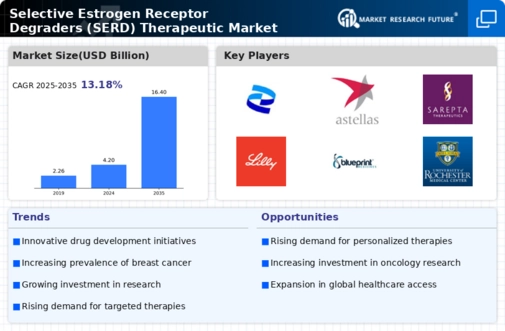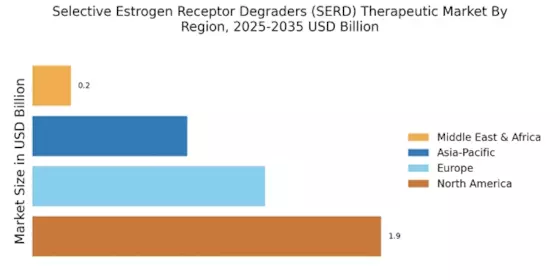Rising Investment in Oncology Research
The rising investment in oncology research is a significant driver for the Selective Estrogen Receptor Degraders (SERD) Therapeutic Market. Increased funding from both public and private sectors is being directed towards the development of novel cancer therapies, including SERDs. This influx of capital is fostering innovation and enabling researchers to explore new therapeutic avenues for hormone receptor-positive breast cancer. As a result, the SERD market is likely to witness a surge in research activities, leading to the discovery of new compounds and treatment strategies. Furthermore, collaborations between academic institutions and pharmaceutical companies are becoming more prevalent, enhancing the overall research ecosystem. This collaborative approach is expected to accelerate the development of SERDs, ultimately benefiting patients and driving market growth.
Regulatory Support for Innovative Therapies
Regulatory support for innovative therapies is a crucial factor influencing the Selective Estrogen Receptor Degraders (SERD) Therapeutic Market. Regulatory agencies are increasingly recognizing the need for expedited approval processes for breakthrough therapies that address unmet medical needs. This trend is particularly relevant for SERDs, which offer novel mechanisms of action for treating hormone receptor-positive breast cancer. The implementation of programs such as accelerated approval pathways and priority review designations is likely to facilitate faster access to SERDs for patients. As regulatory bodies continue to support the development of innovative treatments, the SERD market is expected to benefit from a more favorable approval landscape, ultimately enhancing patient access to these therapies.
Advancements in Drug Development Technologies
Technological advancements in drug development are significantly influencing the Selective Estrogen Receptor Degraders (SERD) Therapeutic Market. Innovations in molecular biology, high-throughput screening, and computational modeling have streamlined the drug discovery process, enabling the rapid identification of potential SERD candidates. These advancements facilitate the development of more targeted and effective therapies, which are crucial in addressing the complexities of hormone receptor-positive cancers. Furthermore, the integration of artificial intelligence in drug design is expected to enhance the efficiency of SERD development, potentially reducing time-to-market. As a result, the SERD market is likely to experience accelerated growth, driven by the continuous evolution of drug development technologies that support the creation of novel therapeutic options.
Growing Awareness and Education on Breast Cancer Treatments
The increasing awareness and education surrounding breast cancer treatments are vital drivers for the Selective Estrogen Receptor Degraders (SERD) Therapeutic Market. As healthcare professionals and patients become more informed about the latest treatment modalities, the demand for innovative therapies like SERDs is expected to rise. Educational initiatives, including workshops, seminars, and online resources, are enhancing understanding of hormone receptor-positive breast cancer and the role of SERDs in treatment. This heightened awareness is likely to lead to more patients seeking advanced therapies, thereby expanding the market for SERDs. Additionally, as patients become more proactive in their treatment choices, healthcare providers may be encouraged to prescribe SERDs, further contributing to market growth.
Increasing Incidence of Hormone Receptor-Positive Breast Cancer
The rising incidence of hormone receptor-positive breast cancer is a pivotal driver for the Selective Estrogen Receptor Degraders (SERD) Therapeutic Market. As more patients are diagnosed with this subtype, the demand for effective treatment options escalates. According to recent statistics, hormone receptor-positive breast cancer accounts for approximately 70% of all breast cancer cases. This growing patient population necessitates innovative therapies, such as SERDs, which target estrogen receptors more effectively than traditional treatments. The SERD therapeutic approach not only aims to improve patient outcomes but also addresses the limitations of existing therapies, thereby enhancing the overall treatment landscape. Consequently, the increasing prevalence of this cancer type is likely to propel the SERD market forward, as healthcare providers seek advanced solutions to meet the needs of their patients.


















Leave a Comment